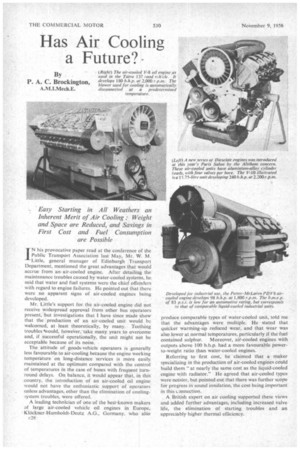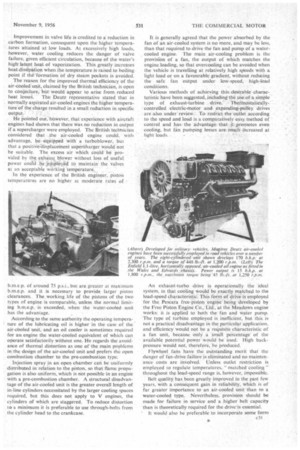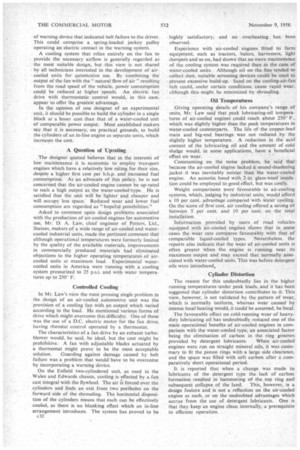Has Air Cooling a Future?
Page 66

Page 69

Page 70

If you've noticed an error in this article please click here to report it so we can fix it.
Easy Starting in All Weathers an Inherent Merit of Air Cooling.' Weight and Space are Reduced, and Savings in First Cost and Fuel Consumption are Possible
IN his provocative paper read at the conference of the Public Transport Association last May, Mr. W. M. Little, general manager of Edinburgh Transport Department, mentioned the great advantages that would accrue from anair-cooled engine. After detailing the maintenance troubles caused by water-cooled systems, he said that water and fuel systems were the chief offenders with regard to engine failures. He pointed out that there were no apparent signs of air-cooled engines being developed.
Mr. Little's support for the air-cooled engine did not receive widespread approval from other bus operators present, but investigations that I have since made show that the production of an air-cooled unit would he welcomed, at least theoretically, by many. Teething troubles•would, however,' take many years to overcome and, if successful operationally, the unit might not be acceptable because of its noise.
The attitude of goods-vehicle operators is generally less favourable to air-cooling because the engine working temperature on long-distance services is more easily maintained at the optimum compared with the control of temperatures in the case of buses with frequent turnround delays. On balance, it would appear that, in this country, the introduction of an air-cooled oil engine would not have the enthusiastic support of operators unless advantages, other than the elimination of coolingsystem troubles, were offered.
A leading technician of one of the best-known makers of large air-cooled vehicle oil engines in Europe, Kleckner-Humboldt-Deutz A.G., Germany. who al§o c28 produce comparable types of water-cooled unit, told me that the advantages were multiple. He stated that quicker warming-up reduced wear, and that wear was also lower at normal temperatures, particularly if the fuel contained sulphur. Moreover, air-cooled engines with outputs above 100 b.h.p. had a more favourable powerto-weight ratio than water-cooled engines.
Referring to • first cost, he claimed that a maker specializing in the production of air-cooled engines could build them "at nearly the same cost as the liquid-cooled engine with radiator." He agreed that air-cooled types were noisier, but pointed out that there was further scope for progress in sound insulation, the cost being important in this C7nnection.
. A British expert on air cooling supported these views and added further advantages, including increased valve life, the elimination of starting troubles and an appreciably higher thermal efficiency. improvement in valve life is credited to a reduction in carbon formation, consequent upon the higher temperatures attained at law loads. At excessively high loads, however, water cooling reduces the danger of valve failure, given efficient circulation, because of the water's high latent heat of vaporization. This greatly increases heat dissipation when the temperature is raised to boiling point if the formation of dry steam pockets is avoided.
The reason for the improved thermal efficiency of the air-cooled unit, claimed by the British technician, is open to conjecture, but would appear to arise from reduced heat lossei. The Deutz representative stated that in normally aspirated air-cooled engines the higher temperature of the charge resulted in a small reduction in specific output He Pointed out:however, that experience with aircraft engines had shown that there was no reduction in output if a supercharger were employed. The British teclenician considered that the air-cooled engine could, with advantage, be equipped with a turboblower, bus that a positive-displacement superCharger would not be suitable. The excess air which could be provided by the exhaust blower without loss of useful power could be ,erripleyed to maintain the valves at an acceptable working temperature._ • In the experience of the British engineer, piston temperateres are no higher at moderate rates of b.m.e.p. of around 75 psi., but are greater at maximum b.m.e.p. and it is necessary to provide larger piston clearances.. The working life of the pistons of the two types of engine is comparable, unless the normal limiting b.m.e.p. is exceeded, when the water-cooled unit has the advantage.
According to the same authority the operating temperature of the lubricating oil is higher in the case of the air-cooled unit, and an oil cooler is sometimes required for an engine the water-cooled equivalent of which can operate satisfactorily without one. He regards the avoidance of thermal distortion as one of the main problems in the design of the air-cooled unit and prefers the open combustion chamber to the pre-combustion type.
Injection spray in an open chamber can he uniformly distributed in relation to the piston, so that flame propagation is also uniform, which is not possible in an engine with a pre-combustion chamber. A structural disadvantage of the air-cooled unit is the greater overall length of in-line cylinders necessitated by the larger cooling spaces required, but this does not apply to V engines, the cylinders of which are staggered. To reduce distortion to a minimum it is preferable to use through-bolts from the cylinder head to the crankcase. It is generally agreed that the power absorbed by the fan of an air-cooled system is no more, and may be less, than that required to drive the fan and pump of a watercooled engine. The main air-cooling problem is the provision of a fan, the output of which matches the engine loading, so that overcooling can be avoided when the vehicle is travelling at relatively high speeds with a light load or on a favourable gradient, without reducing the safe fan output under low-speed, high-load conditions.
Various methods of achieving this desirable characteristic have been suggested, including the use of a simple type of exhaust-turbine drive. Thermostaticallycontrolled electric-motor and expanding-pulley drives are also under review. To restrict the outlet according to the speed and load is a comparatively easy method of control and has the advantage that it promotes even cooling, but fan pumping losses are much increased at light loads.
An exhaust-turbo drive is operationally the ideal system, in that cooling would be exactly matched to the load-speed characteristic: This form of drive is employed for the Pescara free-piston engine being developed by the Free Piston Engine Co.; Ltd., at the Meadows engine works: it is applied to both the fan and water pump. The type of turbine employed is inefficient, but this is not a practical disadvantage in the particular application, and efficiency would not be a requisite characteristic of a fan unit, because only a Small percentage of the available potential newer would be Used. High backpressure would not, therefore, be Produced.
Flywheel fans have the outstanding merit that the danger of fan-drive failure is eliminated and no maintenance costs are involved. Unless outlet restriction is employed to regulate temperatures. matched cooling " throughout the load-speed range is, however, impossible.
Belt quality has been greatly improved in the past few years, with a consequent gain in reliability, which is of far greater importance to an air-cooled unit' than to a water-cooled type. Nevertheless, provision should be made for failure in service and a higher belt capacity than is theoretically required for the drive'is essential.
' It would also be preferable to incorporate some form
of warning device that indicated belt failure to the driver. This could comprise a spring-loaded jockey pulley• operating an electric contact in the warning system.
A cooling system that relies entirely on the fan to provide the necessary airflow is generally regarded as the most suitable design, but this view is not shared by all technicians interested in the development of aircooled units for automotive use. By combining the . output of the fan with the' natural flow of air" resulting from the road speed of the vehicle, power consumption could be reduced at higher speeds. An electric fan drive with thermostatic control would, in this case, appear to offer the greatest advantage.
In the opinion of one designer of an experimental unit, it should be possible to build the cylinder in a single block at a lesser cost than that of a water-cooled unit of comparable power output. Most established makers say that it is necessary, on practical grounds, to build the cylinders of an in-line engine as separate units, which increases the cost.
A Question of tprating The designer quoted believes that in the interests of low maintenance it is economic to employ transport engines which have a relatively low riting for their size, despite a higher first cost per b.h.p. and increased fuel consumption. As an advocate of this policy, he is not concerned that the air-cooled engine cannot be up-rated to such a high output as the water-cooIedktype. He is satisfied that the unit will be lighter and cheaper and will occupy less space.. Reduced wear and lower, fuel consumption are regarded as "hopeful possibilities.",
Asked to comment upon design problems associated with the production of air-cooled engines for automotive use, Mr. D. A. Law, chief engineer of Petters, Ltd., Staines, makers of a wide range of air-cooled and watercooled industrial units, made the pertinent comment that although operational temperatures were formerly limited by the quality of the available materials, improvements in commercially produced materials had eliminated objections to the higher operating temperatures of aircooled units at maximum load. Experimental watercooled units in America were running with a cooling system pressurized to 25 psi. and with water temperatures up to 250° F.
Controlled Cooling
In Mr. Law's view the most pressing single problem in the design of an air-cooled automotive unit was the provision of a cooling fan with an output which varied according to the load. He mentioned various forms of drive which might overcome this difficulty. One of these was the use of a D.C. electric motor for the fan drive, having rheostat' control operated by a thermostat.
The characteristics of a fan drive by an exhaust turboblower would, he said, be ideal, but the cost might be prohibitive. A fan with adjustable blades actuated by a thermostat might prove to be the most acceptable solution. Guarding against damage caused by belt failure was a problem that would have to be overcome by incorporating a warning device.
On the Enfield two-cylindered unit, as used in the Wales and Edwards chassis, cooling is effected by a fan cast integral with the flywheel. The air forced over the cylinders and finds an exit from two portholes on the forward side of the shrouding. The horizontal disposition of the cylinders means that each can be effectively cooled, as there is no blanking effect which an in-line arrangement introduces. The system has proved to be (32 highly satisfactory, and no overheating has been observed.
Experience with air-cooled engines fitted to farm equipment, such as tractors, balers, harvesters, light dumpers and so on, had shown that no more maintenance of the cooling system was required than in the case of Water-cooled units. Although oil on the fins tended to collect dust, suitable screening devices could be used to prevent excessive build-up. Sand on the cooling-air-fan belt could, under certain conditions, cause rapid wear, although this might, be minimized by shrouding.
• Oil Temperatures
Giving operating details of his company's range of units, Mr. Law said that peak lubricating-oil temperatures of air-cooled engines could reach about 250° F., which was slightly higher than the peak temperatures in water-cooled counterparts. The life of the copper-lead main and big-end bearings was not reduced by 'the slightly higher temperature. A reduction in the acid content of the lubricating oil and the amount of cold sludge would, in some applications, have a beneficial effect on wear.
Commenting on the noise problem, he said that because the air-cooled engine lacked a sound-deadening jacketit was inevitably noisier than the water-cooled engine. An acoustic hood with 27in, glass-wool insulation could be employed to good effect, but was costly.
Weight comparisons were favourable to air-cooling systems, which, judging by industrial units, would afford a 10 per eent. advantage compared with Water cooling. On the score of first cost, air cooling offered a saving of between 5 per cent. and 10 per bent. on the total installation.
Information provided by users of road vehicles equipped with air-cooled, engines srtows that in some cases the wear rate compares favourably with that of comparable liquid-cooled types. Nevertheless, the reports also indicate that the wear of air-cooled units is often greater when the engine is running near its maximum output and may exceed that normally associated with water-cooled units. This was before detergent oils were introduced,
Cylinder Distortion
The reason for this undoubtedly lies in the higher running temperatures under peak loads, and it has been suggested that cylinder distortion contributes to it. This view, however, is not validated by the pattern of wear, which is normally uniform, whereas: wear caused by intense local heating would, it could be assumed, be local.
The favourable effect on cold-running wear of heavyduty lubricating oil has undoubtedly reduced one of the main operational benefits of air-cooled engines in comparison with the water-cooled type, an associated factor being the elimination of carbon in the ring grooves provided by detergent lubricants. When air-cooIed engines were run on straight mineral oils, it was customary to fit the piston rings with a large side clearance, and the space was filled with soft carbon after a comparatively short operational period.
It is reported that when a change was made to lubricants of the detergent type the lack of carbon formation resulted in hammering of the .top ring and subsequent collapse of the land. This, however, is a design feature and is not a reflection on the air-cooled engine as such, or on the undoubted advantages which accrue from the use of detergent lubricants. One is that they keep an engine clean internally, a prerequisite to efficient operation.




























































































































